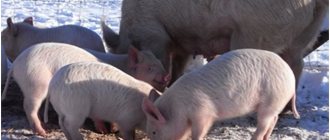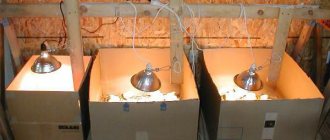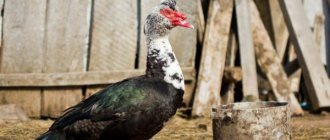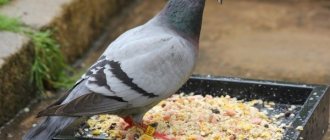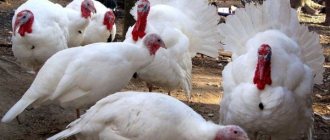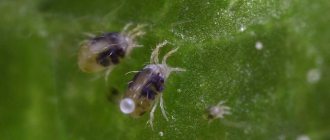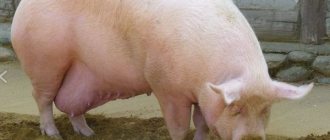12 minutes to read the article
PhotoVideoComments
Pig breeding is considered one of the most profitable types of business in any country. It does not require any special expenses and quickly pays back the investment. The main thing is to provide the pigs with proper care and normal feeding so that they grow quickly. In this article we will look at which pig fattening is the most effective and how best to organize it.
The pig breeding business will be profitable if the pig fattening process is properly organized.
The fact that labor costs and financial investments pay off quickly can be judged by the following facts:
- one sow is capable of producing up to 15 small piglets;
- Pigs need to be fattened within one year;
- You can organize production even at home, if you have a separate house.
There are several technologies that allow you to quickly and efficiently fatten piglets for meat at home. As a result, well-fed carcasses with high quality meat grow. The profit you receive depends on how effective the pig fattening method is.
Features of effective fattening of pigs and piglets on private farms
Experienced farmers are well aware that for the quality raising of pigs in households, not only their breed plays an important role, but also heredity and the conditions in which they are kept. An equally important condition in livestock farming is proper balanced feeding of the livestock.
Pig breeds with photographs and names, brief descriptions and characteristics (read more)
In this article we will talk about fattening pigs and piglets at home. How to effectively fatten pigs in personal farming conditions. Let's talk about the main types of feed and the features of their use.
Features of effective fattening of pigs and piglets on a private farm.
Note! There are certain breeds whose livestock are characterized by fairly high productivity compared to others, but this can only be achieved with high-quality fattening. Therefore, to ensure future income from pig farming, the main thing is to invest in properly selected, balanced and effective feed and, of course, feeding itself.
Growth stimulants
The acceleration of pig growth that breeders want to achieve cannot be achieved without the use of additional stimulants. Such stimulants can be either already included in some concentrates or sold separately, for example, in the form of capsules added manually to mixtures.
Since breeders are interested in piglets eating less but gaining more, they should pay attention to the following drugs:
- amylosubtilin – this drug contains active substances that promote rapid weight gain and at the same time affect the reduction of fat deposits. This drug also reduces the appetite of animals, allowing breeders to save on feed;
Amylosubtilin
- etonium - the effect of the drug is similar to the action of amylosubtilin. By increasing the overall weight of piglets, etonium prevents the growth of adipose tissue and regulates appetite. The substance promotes the production of pig acids, which are beneficial for humans.
Etonium is available as an injection
First group of stimulants
There are several groups of growth stimulating additives, but in private yards the first group is most often used, which includes:
- vitamin and mineral supplements;
- protein supplements;
- amino acids.
All these substances have a gentle effect on the pig’s body, without causing hormonal imbalances or other health problems. They improve the functioning of the gastrointestinal tract of animals and strengthen their immunity.
Examples of stimulants and concentrates that accelerate pig growth
Often vitamin, protein supplements and amino acids are sold in the form of ready-made mixtures - premixes, which breeders add to combined feeds. Since the market for such mixtures is wide, inexperienced breeders are advised to consult a veterinarian before purchasing, as there is a high risk of making a fatal mistake.
We tell you more about premixes below.
The role of premixes in pig fattening
Prices for premix for pigs
Premix for pigs
Second group of stimulants
The second category of supplements includes antibiotics and hormones, which are used only by professional breeders. The use of such drugs at home is completely impractical.
Hormones or antibiotics should only be administered to animals with the permission of a veterinarian
Drugs of the second group are prescribed very carefully, due to the fact that some of them tend to accumulate in animal tissues. There is not enough data on the impact of such meat eaten by humans. Most breeders are wary of such substances and resort to them only in extreme cases when the piglets are in danger of death.
The course of taking antibiotics or hormones ends strictly two weeks before slaughtering the pig in order to minimize the consequences of their consumption.
Types of fattening used on private farms
It is widely known that feeding pigs is a very difficult technological process. Farmers invest a lot of effort, knowledge and money to achieve the desired result. The use of different types of fattening is used to obtain different types of good meat and tasty lard.
The most common types are:
- Meat fattening of pigs. Its use is advisable when trying to obtain leaner meat. Then pigs weighing more than one hundred kilograms and about 7 months old (the edible part is about 70% of the total live weight) are slaughtered. In order to increase the proportion of edible mass to 85%, gilts should be fattened to 130 kilograms.
- Bacon fattening of pigs should be used when trying to obtain meat with small layers of fat. Then it turns out more tasty. That is why creating an effective diet is very important. It is also important to choose those breeds of pigs that are suitable specifically for this type of feeding. Gilts weighing no more than 100 kg are sent for slaughter. Please note that in young animals the body should be elongated, the chest and back should be wide, and the ham should be strong. By 12 weeks, the weight of gilts should approach 25 kg.
- Fattening pigs to fatty condition . To obtain fattier meat, gilts must be special breeds or cull sows. With this type of feeding, high-quality lard is obtained, with a height of no more than 10 cm. If all fattening conditions are met correctly, then the live weight of the pig should contain about 50% lard, and up to 40% meat.
Note! The specific type of fattening is used depending on what breed of pigs the farmer has, the type of feed and what kind of products are needed as a result.
According to statistics, now consumers more often choose more dietary, low-fat, leaner meat, so farmers rely on meat gilts to produce a competitive product in the livestock market.
Meat fattening. The most popular and economically profitable type of fattening, which allows you to get tender, lean meat in a short time, which is in demand among consumers. In this way, most pigs are fattened from 3-4 to 6-8 months, until their body weight reaches 100-110 kg.
Note! The body of a fattened pig must receive a large amount of protein (from 170 g per 1 kg of feed in the initial phase to 140 g in the final phase). To do this, the pig’s feed must include fish and meat and bone meal, yeast, whey or skim milk. The diet may also contain food and grain waste, potatoes, sugar beets, and combined silage.
It is recommended to give food to the pig in equal parts 2 or 3 times a day or pour it into bunker feeders with free access to them.
At the beginning of meat fattening, the average daily weight gain of a pig should be 600-750 g, and by the end - 800-900 g. If the recommended indicators are not achieved, the period of meat fattening is extended. In turn, meat fattening is usually divided into two- or three-phase.
In two-phase meat fattening, grower and finishing complete feed are used:
- Phase 1 - gilts weighing from 25-30-35 kg to 65 kg
- Phase 2 - pigs weighing from 65-70 kg to 95-110 kg
In three-phase meat fattening, three types of feed are used: grower, 1st finishing period and 2nd finishing period:
- Phase 1 - gilts weighing 30-50 kg;
- Phase 2 - pigs weighing 50-80 kg;
- Phase 3 - pigs weighing 80-110 kg.
As a type of meat, bacon fattening is also distinguished with increased requirements for it: the weight of pigs should not exceed 100 kg, otherwise the bacon will be dry and tough.
The bacon fattening period consists of two phases:
- Phase 1 - gilts weighing 25-30/50-65 kg with a minimum weight gain of 650-750 g per day.
- Phase 2 - pigs weighing 60-65/80-95 kg with a minimum weight gain of 800-900 g per day.
Meat-fat fattening. In fact, it is no different from meat, with the only difference that it lasts longer - up to 2-4 months. In this case, pigs of specialized breeds are selected (Estonian, Landrace, Tamworth), which are fattened to 90-100 kg. As a result of such fattening, it is possible to obtain fattier pork than with meat fattening.
Feeding techniques for sows (read more)
Greasy fattening. This type of fattening is also called “fattening”, because its goal is to produce fatty carcasses containing 40-50% lard. For this type of fattening, sows are selected after weaning their piglets, culled adult boars and ordinary boars. The recommended feed for feeding fat-fattened pigs is complete feed of the 1st or 2nd finishing period. The animal's weight gain should be 800-1000 g per day.
How to feed breeding boars: (read more)
The duration of the fattening period is 2.5-4 months (fattening stops when the average daily weight gain decreases to 600 g).
It is necessary to select feed for pigs depending on the chosen type of fattening in consultation with experienced specialists.
Final period
It is quite short, only a month and a half. During this period, the weight of pigs per day grows by 750 g, for which the nutrient concentrate is increased by almost 90%, using various supplements. Most often they add to it:
- potatoes, and in such a way that fattening for piglets consists of two parts - first they are given potatoes, then concentrated feed;
- beets, legumes and green grass;
- food waste.
At the final stage, each fattened carcass should contain 100 grams of protein. During this period, it is very important to completely exclude from the diet those foods that can negatively affect the taste of the resulting meat. These include:
- fish;
- bran;
- millet flour;
- soy (remember that it even interferes with normal weight gain).
Bran, fish, millet flour and soy can negatively affect the taste of meat.
At the final stage, the pigs are fed twice a day; water must be present at all times. It is not advisable to disturb them. To make this period as effective as possible:
- the room where the pigs are kept is darkened from bright light;
- pigs need to be taken out for walks less often, reducing this time to a minimum.
Here is a table of effective fattening of pigs for meat
| Live weight | Gain per day | Daily requirement for one individual | Consumption of feed units per 1 kg of gain | |||||
| feed units | digestible protein, g | salt, g | calcium, g | phosphorus, g | carotene, mg | |||
| 20-30 | 300-400 | 1,4 — 1,7 | 175 — 215 | 14 | 10 | 8 | 5 | 4,2 |
| 30-40 | 1,5 — 1,7 | 180 — 225 | 15 | 12 | 9 | 7 | 4,5 | |
| 40-50 | 400-500 | 2,0 — 2,3 | 220 — 265 | 20 | 14 | 10 | 8 | 4,6 |
| 50-60 | 2,1 — 2,4 | 240 — 275 | 22 | 15 | 11 | 10 | 4,8 | |
| 60-70 | 500-600 | 2,6 — 3,0 | 260 – 330 | 25 | 16 | 12 | 12 | 5,0 |
| 70-80 | 600-700 | 3,2 — 3,7 | 320 – 390 | 32 | 17 | 13 | 15 | 5,2 |
| 80-90 | 3,3 — 3,8 | 330 – 410 | 18 | 14 | 5,4 | |||
| 90-100 | 700-800 | 3,9 — 4,4 | 355 — 415 | 35 | 20 | 16 | 5,5 | |
| 100-120 | 4,0 — 4,5 | 360 — 420 | 22 | 18 | 5,6 | |||
How much feed does a pig need for fattening: daily calculation of feed for pigs
To effectively increase a pig's body weight in a short time, you need to know what to feed it and in what quantity. After all, both a lack and an excess of food negatively affects the quality of meat. Therefore, daily feed requirements are specially calculated, which depend on the weight, age and sex of the pig. Animal body weight is monitored by monthly weighing.
Note! At different age stages, the daily feeding standards for pigs will differ.
Dairy stage (piglets aged 0-2 months):
- 0-2 weeks - 25 g of food;
- 1 month - 350 g of food;
- 2 months - 850 g of food.
Weaning stage (piglets aged 2-4 months):
- 3 months - 1050 g of food;
- 4 months - 1550 g of food.
Fattening stage (piglets under 8 months of age weighing up to 100 kg):
- up to 5 months - 2250 g of food;
- 6 months - 2550 g of food;
- 7 months - 3200 g of food;
- 8 months - 3350 g of food.
It is estimated that within 1 year a pig at a certain age eats:
- piglet from birth to 2 months - 150-170 kg of feed;
- 2-4 month old pig - 480-570 kg of feed;
- 4-6 month old individual - 910-1060 kg of feed;
- adult boar - 1400-1650 kg of feed;
- sow - 1480-1800 kg of feed.
Note! For feed from different manufacturers, different feeding rates per day are provided.
Frequency of placing food in troughs
So, now you know how to raise piglets for fattening to produce quality meat. Next, let's look at how many times a day you should fill animal troughs with food. Dairy piglets, as mentioned above, are given food 5-6 times a day. For adolescent pigs under 4 months of age, troughs are filled three times a day. Later, if the amount of grain in the diet of young animals reaches 1.5 kg per head, they switch to twice feeding. When mash predominates on the menu, three meals a day are maintained.
Features of fattening pigs in 6 months: how to fatten a pig up to 120 kg in 6 months?
As you know, proper fattening of pigs is the key to obtaining high-quality products (meat, bacon, lard) in large quantities. Experienced farmers know the nuances of feeding and adhere to the specifics of fattening at each stage of pig growth. Even at home, it is quite possible for a pig to gain 120 kg in six months, if it is provided with good living conditions and appropriate care. And you will learn further about what exactly fattening should be like.
Features of fattening pigs for 6 months.
The time allotted for fattening a pig is usually divided into three periods:
Lactic. Continues during the first 3 weeks from birth. At this time, the piglet feeds only on mother’s milk, and in its absence, cow’s or goat’s milk at the rate of 3 liters of milk per head. Porridges made from any type of small cereals are also suitable (normally 1 liter per animal), which are given to piglets at least 4-5 times a day, starting from the age of 1-2 weeks. As a mineral fertilizer, it is recommended to add chalk, charcoal, turf, and hay dust to the feeder in a dosage of 5-10 ml.
Growing. After weaning piglets from their mother’s milk, concentrated feed already appears on the menu, which is given in an amount of about 0.7-0.8 kg per day during the first month, increasing to 1 kg in the second month. From the age of 3 months, the frequency of feeding piglets is reduced to three times a day. From now on, milk for them can be diluted with water in a 1:1 ratio and gradually replaced with whey or skim milk (skimmed milk). It's time for thick, wet mash to appear in the pigs' diet. It is important that animals have the opportunity to walk around their territory.
Fattening. In order for a pig to actively gain weight from 5 months, during this period its nutrition should be the most high-calorie, and movement should be limited. For this purpose, animals are placed in small pens. The diet of pigs at 5-6 months of fattening consists of food waste, boiled root vegetables, cake, and feed mixtures. It is recommended to give the listed food to animals 2 times a day.
Depending on what type of final product is planned to be obtained, food for the pig is selected. If the goal is meat, the food must contain greens with a daily allowance of 5 kg and mixed feed. In addition, “meat” pigs are fed vegetables: beets, potatoes, pumpkin. And of course, chalk and salt are added to the food - approximately 5-35 g per day. If the priority is fattening the pig for lard, then the basis of its diet should be food rich in carbohydrates, as well as barley and millet.
Note! If you follow a special diet for each period, the pig will gain up to 1 kg of weight per day.
Technologies
Depending on what result you want to achieve, i.e., whether you want to raise pigs for meat, bacon or lard, there are corresponding types of fattening. Let's give them a brief description.
- Meat. By seven months, piglets will gain weight of 100 kilos or more. By this time, their meat will become very tasty and will contain little fat. The edible portion of the carcass will be about 75%. If a grown piglet weighs about 130 kilos, the edible part will increase to 85% of the weight.
- Bacon. This is considered meat that is evenly soaked in fat. To get this result, you will need to select a special breed of pigs and adhere to a special diet in feeding them. Piglets for fattening are chosen to be oblong in shape, with a wide chest and back, with pronounced legs. Best suited for this purpose:
- Estonian white breed;
- Lithuanian white breed;
- landraces.
By three months, piglets of these breeds are already able to increase their weight by 25 kilos. You can breed them at home, but the livestock breeder will need not only professional knowledge of how to properly fatten pigs, but also attention, as well as significant financial investments at the initial stage.
- High quality bacon. This option is most in demand in households. Good bacon can be obtained from very fatty meat, for which piglets are selected from a special meat-fat breed. In order to achieve the desired effect, the livestock breeder will have to constantly control the fat content of the meat and the thickness of the bacon. The latter should not exceed 10 centimeters. If you correctly observe the required standards in the nutritional diet of animals, then the total live weight should result in:
- 50% bacon;
- 40% meat.
Depending on the desired end product, it is necessary to select different breeds of pigs for fattening.
Diet of fattening pigs: features of the diet of fattening pigs
Starting from the 11th week, young pigs weighing 30-35 kg begin to be intensively fattened. On average, the duration of fattening is about a year, and at the end of this period, each sow is capable of giving birth to at least 10 piglets. Therefore, the pig farming industry is considered highly profitable.
Feeding sows before farrowing: (read more)
Depending on the type of pig feeding (dry or wet), granulated or bulk feed is selected for the animals. The latter is represented by feed mixtures or feed mixtures made on the basis of premixes of different concentrations or mixed feed. In this case, the size of the crushed particles is of great importance: the smaller they are, the better they are absorbed by the body. However, the intake of too finely ground food into the body is also undesirable, because... this can cause digestive problems in pigs.
Note! The high efficiency of dry feeding is achieved through the use of granulated feed, which in its form is more accessible for absorption by the animal’s body.
Diet of fattening pigs.
In particular, feeding pigs with ready-made mixed feed gives an increase in their growth by 6-11% while reducing feed consumption by 8-10%.
Feed additives
To improve metabolic processes, growth and development of animals, normalize daily growth, protect pets from diseases and increase immunity, feed additives are introduced into their food:
- When fattening fat pigs, Amylosubtilin GZH is used as an additive, which accelerates the deposition of fat and also helps reduce feed consumption by 12%.
- The introduction of etonium into the diet will help improve the quality and increase the quantity of pig products. It is recommended to add 0.5 mg of the drug per 1 kg of animal weight per day.
- Stimulation of growth is carried out with the introduction of water-soluble acids and the drug betazine into the diet.
- Monosodium glutamate will help your pets digest food better.
- Azobacterin will supply the pig’s body with nitrogen substances and vitamin B12.
Important! As an additive to the main diet, mixed feed is used as a source of missing nutrients. In addition, the pig should consume up to 6–7 liters of fluid.
What does the diet of fattening pigs include?
Fattened pigs need protein the most. So, in the initial period its norm is 115-120 g, and at the end of fattening the need decreases to 90-100 g per unit of feed.
In general, the intake rates of digestible protein depend on the weight of the pig:
- for individuals weighing 40-60 kg: 270-280 g of protein;
- for individuals weighing 60-80 kg: 350 g of protein;
- for individuals weighing 80-100 kg: 415 g of protein.
The main source of protein is grain feed, which is included in the diet of pigs after pre-processing - peeling the grain from the shell and grinding in mills to an optimal size of 1.5 mm. Legumes, boiled potatoes, alfalfa, carrots, fodder and sugar beets, cake, and mixed feed are also used for fattening pigs.
Maintaining pigs' appetite
In order for animals to eat better and, accordingly, gain weight faster, feed should be prepared. Typically, such additional measures are taken when fattening pigs for lard. But in some situations, these techniques can also be useful when raising animals for meat. Before feeding, for example, grains, they are subjected to a malting procedure. It consists of pre-soaking concentrated feed with hot water (85-90 degrees) for about 4 hours. In this case, take approximately 1.5-2 liters of liquid per kilogram of grain.
If the pigs do not finish the mash, the leftovers can be poured with pre-prepared oat milk. Pigs like the food improved in this way much more than usual.
To prepare such milk, one kilogram of oatmeal is poured with boiled, cooled water and stirred. The chatterbox should stand in a warm room for about three hours.
What is included in the diet of bacon-fed pigs?
The diet of Landrace pigs - the main one for producing meat for bacon - consists of legumes, wheat, barley, rye in limited quantities, potatoes and root vegetables, whey and skim milk. The rate of protein intake into the body of pigs at the first of two stages of fattening is 120-130 g per feed unit, and at the second stage - 100-110 g. In the menu of bacon-fattened pigs, the main place is occupied by concentrates, the consumption of which depends on the weight of the pig:
- — 1.2 kg of concentrates containing 50% barley, 30% oats, 10% peas, 10% wheat bran.
- - up to 1.7 kg of concentrates of the same composition as in the first growing period.
- — 2.3 kg of concentrates containing 70% barley, 20% peas, 10% oats.
Keeping animals for fattening
Most often, pig fattening begins in the spring and summer. There are also certain requirements for a pigsty.
It must be:
- warm;
- dry;
- no drafts;
- with a well-designed ventilation system.
It is advisable that the pigsty can dim the lights after feeding. The organization of walking areas is no less important, especially for meat and bacon fattening.
Strong, robust animals that are aggressive towards their relatives, as well as leaders, should be kept separately from weaker ones in order to avoid clashes and injury. To do this, the height of the walls and partitions in the shed must be at least a meter.
The area of the pigsty itself depends on the animals that are kept in it.
Approximate dimensions:
- per sow – 4-5 m2;
- for a young pig – 3-4 m2;
- for a wild boar - at least 5 m2.
The best types of feed for pigs
As in any other livestock industry, the ultimate goal of pig breeding is the profit that the farmer receives from the sale of meat products. And one of the main conditions for obtaining it, along with good heredity of the breeds and proper living conditions, is proper feeding of the animals.
The best feed for pigs.
Dry food. Various grains (barley, oats, peas, corn) are a source of carbohydrates, proteins and fiber for pigs. Barley is responsible for the quality of meat and lard of animals, which is almost 90% digestible by them. In terms of fat and fiber content, oats are the leader among cereals, which in combination with barley is advisable to feed to suckling piglets, young animals and suckling queens. Feeding steamed peas, which act as a supplier of complete proteins, is suitable for pigs of all ages. The high percentage of fats and carbohydrates in corn requires its inclusion in the diet, however, due to the low protein content, it is necessary to reduce the amount of corn at the end of the fattening period.
Juicy feed. These include potatoes, carrots, fodder and sugar beets. Depending on the type of fattening, boiled potatoes should make up from 20% to 40% of the pig’s total diet. Carrots containing carotene and vitamin C help increase the immunity of individuals of different ages and improve the taste of meat. Fodder and sugar beets in crushed raw form ensure that animals receive the necessary nutrients into their bodies.
Green food. Greens in the form of clover, beet tops and peas are recommended to be given to pigs both fresh and dried (protein and vitamin-mineral substances are also preserved in hay). The advantage of green food is that the cost of purchasing it is minimal compared to other types of food.
Animal feed. Firstly, this category includes crushed and cooked waste from fish and meat. Being omnivores, pigs also eat them, thereby providing their bodies with the necessary proteins, vitamins and minerals. Secondly, these are dairy products, from which pigs are given milk, whey, and buttermilk.
But the first place in terms of efficiency among food for pigs is occupied by combined silage, for the preparation of which, according to various recipes, raw root vegetables (except potatoes) are needed.
To obtain high-quality meat products, weight gain and improve the taste of meat, special vitamin and mineral supplements - premixes - are added to the feed of piglets, starting from the second week of life. Their regular use allows you to increase the weight of a pig by 4 times in 2 months. And the result of their use is a reduction in fattening time, which leads to a reduction in the cost of meat products.
The best premixes for fattening pigs: composition and characteristics (read more)
On a note! Taking into account the age of pigs, it is worth choosing feed additives with different contents of microelements (magnesium, phosphorus, iron, manganese, sodium, etc.), vitamins (A, E, B6, B12, D3) and antioxidants.
What constitutes the basis of the diet
Feed - how much you need to quickly gain weight
Types of feed are divided depending on nutritional value and main components:
- concentrates, or energy - cereals, grains;
- protein - legumes, meal, flour;
- coarse - vegetables, hay, bran;
- animals – by-products of dairy and meat production (whey, blood and bone meal).
You can find out about the pig feeding chart here.
You can prepare your own pig feed at home.
Cereals can be prepared by cooking, steaming and yeasting methods. The following recipe is often used:
- For 1 kg of grain take 2 liters of hot water. The feed is filled with water and mixed, covered with burlap to obtain a steamed product. In 5 hours it is ready.
Among succulent feeds, silage is considered quite valuable. Recipes for home cooking:
Recipe 1:
- 60% sugar beet,
- 30% corn on the cob,
- 10% carrots.
Recipe 2:
- 45% steamed potatoes,
- 50% vegetables,
- 5% grain waste.
The silage mass must be crushed and placed in prepared tanks or pits. The mass is well compacted and covered. To reduce moisture, you can add about 7% peas. For 100 kg of silage add 400 table salt.
Compound feed
They combine ingredients from different types of food. Manufacturers produce two types of feed for piglets and adult pigs:
- complete (PC);
- concentrate (CC).
PC provides complete nutrition for pigs that does not require additional additives. According to GOST, a PC includes from 6 to 12 components.
CC is used as a supplement to other feeds and contains proteins, vitamins and minerals.
Premix "Borka" is intended for the preparation of complete feed for fattening pigs.
At home, you can prepare nutritious feed yourself using the following composition:
- barley – 0.4 kg,
- oats – 0.3 kg
- alfalfa flour – 0.16 kg;
- meat and bone meal – 0.12 kg;
- Sunflower cake – 80 g;
- chalk – 20 g;
- salt – 10 g.
Proper organic nutrition
Intensive pig rearing is ineffective without the use of minerals, dietary supplements and vitamins.
For this purpose, special mixtures of active substances are produced - premixes with organic trace elements and amino acids. Plant proteins are extracted by enzymatic hydrolysis and combined with microelements. Such organic complexes are called bioplexes; they are better absorbed than minerals in feed. Alltech bioplex produced in Great Britain includes:
- iron 50000 mg/kg,
- zinc – 20000 mg/kg,
- manganese – 15000 mg/kg,
- copper – 5000 mg/kg,
- selenium – 200 mg/kg.
The use of bioplexes is a promising method of enriching and balancing the diet of piglets.
Additives for rapid fattening of pigs for meat
The intensive type of fattening of young animals involves the use of growth stimulants. Feed additives with vitamin, mineral, bioactive, and antibiotic properties are used. Additives stimulate pigs’ digestion and increase live weight gain.
The following additives may be found in the diet of pigs:
- Amylosubtilin GZH, which stimulates fat deposits in pigs;
- Etonium increases growth and quality of meat,
- Betazin – increases growth rate, reduces feed consumption;
- Azobacterin satisfies the portability of nitrogen and vitamin B 12;
- Monosodium glutamate stimulates the appetite of pigs, improves the taste of meat;
Organic acids (succinic, citric and glutamic) also have a positive effect on growth stimulation.
Antibiotics grizin, hygromycin, biovit, icin, flavomycin and others are also used to stimulate growth.
Antibiotics and stimulants should be used in accordance with regulations.
What to feed pigs for rapid growth
It is beneficial for the owner for the pig to grow as quickly as possible. It cannot be said that the addition of vitamin-mineral premixes accelerates the growth of pigs. But without vitamins and minerals, the development of piglets stops. Therefore, premixes are required for normal pig growth.
Growth “accelerators” are antibiotics that fight pathogenic microflora. Without gastrointestinal infections, a pig grows slightly faster than one that spends energy fighting microorganisms. When growing for sale, it is beneficial to use such bactericidal preparations. They can usually be found on sale under the name “growth accelerators.” One of these drugs is Etonium.
The advantages of any antibacterial drugs are that fattened pigs get sick less and gain weight better. The disadvantages from the consumer's point of view are medications.
Attention! When raising pigs for breeding, it is better not to use growth accelerators.
With accelerated growth, bones and joints do not have time to form. The animal grows up disabled. But for the future of meat this does not matter.
